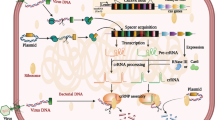Abstract
Using a previously created Mycobacterium avium genomic library with GFP-promoter trap in Mycobacterium smegmatis, we screened for genes that are upregulated upon infection of A. castellanii. Clones exhibiting a 2.5-fold or greater increase in GFP expression, out of a total of 10,000 clones, were selected for further examination. Upregulation was confirmed in subsequent experiments. A total of 20 clones showed an increase in expression 24 and 48 h after infection. Homologues were identified, and genes were found to encode for a variety of functions, including metabolic pathways, protein transcription and translation, and macromolecule degradation. Eight out of the 20 genes were found to be the same as those upregulated upon human macrophage infection. Five genes were selected to confirm upregulation in M. avium following amoeba infection, using real time PCR. All 5 genes were found to be upregulated at least 2.5-fold in M. avium. These results showed that the GFP promoter library in M. smegmatis is a valid system for studying gene upregulation in M. avium systems, and that many M. avium genes are commonly upregulated following macrophage and amoeba infection.


Similar content being viewed by others
Literature Cited
Altare F, Durandy A, Lammas D, Emile JF, Lamhamedi S, Le Deist F, Drysdale P, Jouanguy E, Doffinger R, Bernaudin F, Jeppsson O, Gollob JA, Meinl E, Segal AW, Fischer A, Kumararatne D, Casanova JL (1998) Impairment of mycobacterial immunity in human interleukin-12 receptor deficiency. Science 280:1432–1435
Baek SH, Rajashekara G, Splitter GA, Shapleigh JP (2004) Denitrification genes regulate Brucella virulence in mice. J Bacteriol 186:6025–6031
Brown RC, Bass H, Coombs JP (1975) Carbohydrate binding proteins involved in phagocytosis by Acanthamoeba. Nature 254:434–435
Cirillo JD, Falkow S, Tompkins LS, Bermudez LE (1997) Interaction of Mycobacterium avium with environmental amoebae enhances virulence. Infect Immun 65:3759–3767
Cirillo SL, Yan L, Littman M, Samrakandi MM, Cirillo JD (2002) Role of the Legionella pneumophila rtxA gene in amoebae. Microbiology 148:1667–1677
Danelishvili L, Poort MJ, Bermudez LE (2004) Identification of Mycobacterium avium genes up-regulated in cultured macrophages and in mice. FEMS Microbiol Lett 239:41–49
Davies B, Edwards SW (1991) Chemiluminescence and superoxide production in Acanthamoeba castellanii: free radicals generated during oxidative stress. J Gen Micro 137:1021–1027
Dorman SE, Picard C, Lammas D, Heyne K, van Dissel JT, Baretto R, Rosenzweig SD, Newport M, Levin M, Roesler J, Kumararatne D, Casanova JL, Holland SM (2004) Clinical features of dominant and recessive interferon gamma receptor 1 deficiencies. Lancet 364:2113–2121
Falkinham JO 3rd (2003) Factors influencing the chlorine susceptibility of Mycobacterium avium, Mycobacterium intracellulare, and Mycobacterium scrofulaceum. Appl Environ Microbiol 69:5685–5689
Falkinham JO 3rd, Norton CD, LeChevallier MW (2001) Factors influencing numbers of Mycobacterium avium, Mycobacterium intracellulare, and other Mycobacteria in drinking water distribution systems. Appl Environ Microbiol 67:1225–1231
Hou JY, Graham JE, Clark-Curtiss JE (2002) Mycobacterium avium genes expressed during growth in human macrophages detected by selective capture of transcribed sequences (SCOTS). Infect Immun 70:3714–3726
Inderlied CB, Kemper CA, Bermudez LE (1993) The Mycobacterium avium complex. Clin Microbiol Rev 6:266–310
Kilby JM, Gilligan PH, Yankaskas JR, Highsmith WE Jr, Edwards LJ, Knowles MR (1992) Nontuberculous mycobacteria in adult patients with cystic fibrosis. Chest 102:70–75
Lock R, Oehman L, Dahlgren C (1987) Phagocytic recognition mechanisms in human granulocytes and Acanthamoeba castellanii using type 1 fimbriated Escherichia coli as phagocytic prey. FEMS Microbiol Lett 44:135–140
Molmeret M, Alli OA, Zink S, Flieger A, Cianciotto NP, Kwaik YA (2002) icmT is essential for pore formation-mediated egress of Legionella pneumophila from mammalian and protozoan cells. Infect Immun 70:69–78
Ochsner UA, Wilderman PJ, Vasil AI, Vasil ML (2002) GeneChip expression analysis of the iron starvation response in Pseudomonas aeruginosa: identification of novel pyoverdine biosynthesis genes. Mol Microbiol 45:1277–1287
Pedersen LL, Radulic M, Doric M, Abu Kwaik Y (2001) HtrA homologue of Legionella pneumophila: an indispensable element for intracellular infection of mammalian but not protozoan cells. Infect Immun 69:2569–2579
Simpson GL, Raffin TA, Remington JS (1982) Association of prior nocardiosis and subsequent occurrence of nontuberculous mycobacteriosis in a defined, immunosuppressed population. J Infect Dis 146:211–219
Steinert M, Birkness K, White E, Fields B, Quinn F (1998) Mycobacterium avium bacilli grow saprozoically in coculture with Acanthamoeba polyphaga and survive within cyst walls. Appl Environ Microbiol 64:2256–2261
Teirstein AS, Damsker B, Kirschner PA, Krellenstein DJ, Robinson B, Chuang MT (1990) Pulmonary infection with Mycobacterium avium-intracellulare: diagnosis, clinical patterns, treatment. Mt Sinai J Med 57:209–215
Wagner D, Maser J, Lai B, Cai Z, Barry CE 3rd, Honer Zu Bentrup K, Russell DG, Bermudez LE (2005) Elemental analysis of Mycobacterium avium-, Mycobacterium tuberculosis-, and Mycobacterium smegmatis-containing phagosomes indicates pathogen-induced microenvironments within the host cell’s endosomal system. J Immunol 174:1491–1500
Acknowledgments
We thank Denny Weber for preparing the manuscript. We are also indebted to the members of the Bermudez laboratory for their support and help with the experiments described. This work was supported in part by NIH grant AI-43199.
Author information
Authors and Affiliations
Corresponding author
Rights and permissions
About this article
Cite this article
Tenant, R., Bermudez, L.E. Mycobacterium avium Genes Upregulated Upon Infection of Acanthamoeba castellanii Demonstrate a Common Response to the Intracellular Environment. Curr Microbiol 52, 128–133 (2006). https://doi.org/10.1007/s00284-005-0218-4
Received:
Accepted:
Published:
Issue Date:
DOI: https://doi.org/10.1007/s00284-005-0218-4




